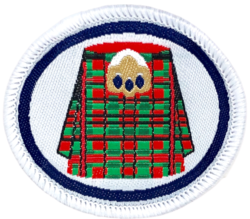Kilts e-Honour
Category: Arts, Crafts and Hobbies
WATCH THE ONLINE TUTORIAL
DOWNLOAD THE PRESENTATION
DOWNLOAD THE WORKSHEET
DOWNLOAD THE ADVANCED WORKSHEET
REQUIREMENTSRequirements
- Define the words:
- kilt
- plaid
- tartan
- sett
- The first written reference of a belted plaid is from what year?
- Be able to recognize the difference between a Great Kilt (Belted Plaid) and a Walking
Kilt.
- Know the benefits of the kilt for the Highlanders.
- Know how much cloth is needed to make a quality kilt and the average time a kiltmaker
spends hand-sewing one kilt to completion.
- Be able to easily identify five different kilt tartans:
- Heritage of Scotland
- Scottish National
- Black Watch
- Royal Stewart
- one of your choice
- Complete three of the following:
- Design/draw your own kilt design and highland dress attire.
- Sew a miniature kilt (doll size), or equivalent, using tartan cloth.
- Create a standing cardboard or card-stock paper doll man in highland dress. Glue/
fasten a piece of tartan fabric onto your model person or create one that can be put
on and removed at will. You may either draw or cut out paper kilt accessory items
(waistcoat, sporran, etc.).
- Research to learn whether or not your family, state/province, or country has a tartan.
- Spiritual Thought:
Everything about the kilt was important as a covering: It protected them from harmful
weather; it kept them warm; it served as a bed; it was adaptable for all circumstances.
Those characteristics also could be used to describe both God’s grace and His
faithful protection. Reflect on Psalm 91:4, Isaiah 30:1, and Habakkuk 2:14 and
discuss what it means for God to cover us. Find another verse to add to this list.
Kilt Honour, Advanced
Requirements
- Have the Basic Kilt Honor
- Have the Tartan Honor
- Investigate the history of the kilt
- Know the historic Gaelic names for the different types of kilts
- Be able to model how to put on a Great Kilt
- Be able to explain the Dress Act of 1776 and Diskilting Act of 1782
- Know whose romantic vision of Gaelic culture and Highland dress brought about the
revival of the kilt?
- Be able to name/identify kilt accessories, such as: sporrans, kilt pin, sgian dubh
(pronounced skee-an doo), and ghillie brogues.
- Do one of the following to see how tartans and kilts are made by:
- Take a mill tour at the Lochcarron of Scotland Visitor Centre in Selkirk
- Visit the Lochcarron Weavers Shop in Loch Carron in Wester Ross, Highlands.
- Visit a local kilt maker
- If you live outside of the UK and none of these are possible, watch documentary
videos on the subject and interview a kilt maker by phone or by email.
- Wear a men’s kilt, ladies tartan skirt, or an equivalent to an event.
- What spiritual application can you draw from kilt-making, history and evolution of the
kilt, or another aspect of this honor? Write a devotional thought from this and be sure
to include a corresponding Bible verse with your thought.
e-HONOUR
We suggest that if there are any presentation elements for the requirements you record a video of yourself and include it with your written assessment in your folder. Your director will check all your work when your club resumes. If all is present and correct, your director can then decide if you may be awarded your honour.
Finished all your requirements? Complete this form online, print off the confirmation and include in your club folder.
For all your Adventurer and Pathfinder supplies, please check your local conference and union shop. For unique BUC badges, supplies and much more, order from www.pfclub.co.uk.
We are not shipping at the moment, but you are able to place your orders online.